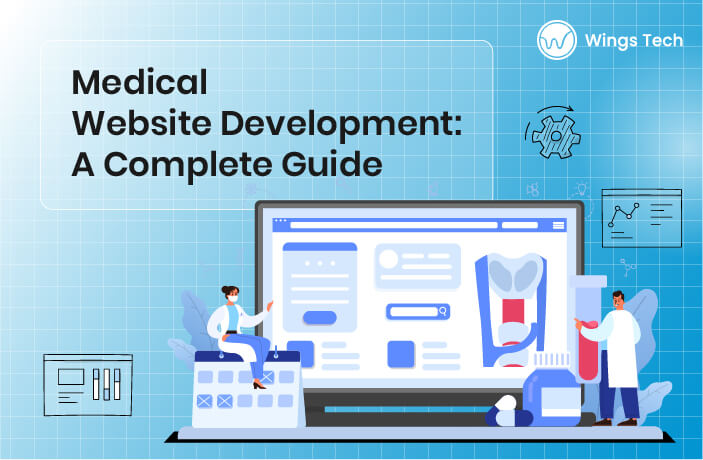Table of Contents
A medical website development project isn’t an aesthetic endeavor, but it’s about the trust it invokes in the visitors. Patients don’t go to healthcare websites for fun; they require instant information, easily accessible services, and a seamless user experience. A poorly developed healthcare website is not only unprofessional; it’s a credibility killer.
Website development for doctors requires the utmost accuracy, regulatory requirements, and a user-friendly design that is liked by tech-savvy patients and those who are learning about online appointments. From HIPAA-compliant patient portals to mobile-first design, a well-developed medical website does more than look great. It provides accessibility, security, and patient engagement, the key to a solid digital presence.
Whether it’s for clinics or hospitals, partnering with an experienced website development consultant can help ensure these factors are implemented efficiently.
Let’s dive deep into the concept of medical website development and find out what it is.
What is Medical Website Development?
Medical website development is the art of creating secure, user-friendly, and regulation-centric online websites tailored to healthcare professionals. While normal business sites are geared toward business requirements, healthcare website design is centered on patient experience, HIPAA-compliant data handling, and seamless integrations for appointment scheduling and telemedicine.
For hospitals, private practices, or clinics, a successful site balances professional looks with functionality, enabling patients to get the right care without digital frustration.
In many cases, healthcare professionals choose Custom WordPress Development to combine user-friendliness with industry-specific functionality.
Why Do You Need a Medical Website?
You continue to record appointment schedules on adhesive notes and wonder why your competitors are growing? It is because your competitors have already gone through with extensive medical website development services, which you haven’t. Here are a few reasons why you need a good healthcare software development service:
Patients’ growing preference for online healthcare services
Patients now search symptoms online before calling a doctor, and in many cases, prefer booking online over the awkward hold message. Your clinic website is now your germ-free digital front door.
Improved patient-doctor communication & appointments
Without regulation-conscious healthcare website development, you’re one data breach away from a legal headache. Encryption and ongoing audits are imminently necessary.
Compliance with Healthcare Regulations (HIPAA, GDPR)
Without a fully regulation-aware healthcare website development, you’re one data breach away from legal migraines. Encryption and regular audits aren’t just fancy words, they are survival gear for your healthcare brand.
Increased credibility and brand authority
Credibility is deeply pixelated nowadays, and a refined website is what your patients need to tell them that you know what you’re doing. This builds trust faster than any ad campaign ever could.
Start your healthcare website today
What is the Process of Medical Website Development?
In medicine, assuming things is malpractice. This is also the case with medical website development. An unorganized site not only loses patients, but it can also put your practice in jeopardy. The following is a strategic roadmap that converts chaos into a patient-focused, compliance-ready digital presence. This website development process ensures your digital infrastructure is future-ready.
Step 1: Requirement analysis
This is where we place the stethoscope in your business. All medical website development starts with a proper diagnosis. I.e., we check if the end user is a multi-specialty hospital managing departments or a solo practitioner tired of managing WhatsApp bookings.
We check if custom features like EHR access, appointment scheduling, and multilingual interfaces are to be set in your medical website. This makes the site work for both patients and doctors without hassle. A custom web application development approach is often used to meet such specific needs.
Step 2: Planning & design
Medical website development isn’t about inserting blue colors and making a sterile web design. It’s about how empathetically your audience can use your website. We try to build a mobile-responsive user interface that’s logically structured, keyboard-friendly, and voice-search compatible. Accessibility is the first point we note while building your website. We make sure that it does not look like the old HTML websites from 2003.
Step 3: Development & integration
Finally, the design is given a skeleton. The developers can write code with HTML5, CSS3, JavaScript, and new frameworks while inculcating APIs for telemedicine, EHRs, analytics & secure payments.
This phase guarantees that the patients can browse smoothly, whether they’re checking from a phone or a desktop. Their browsing experience is always flawless and never disturbed. Backend stability is necessary because bugs ruin credibility even before your medical services do.
Step 4: Security & compliance
Forget fancy websites, your website should also be functional as well as legally full-proof. HIPAA & GDPR are always breathing down your neck. Security features like SSL encryption, secure servers, and encrypted databases are always needed. We also do regular audits & data integrity checks as they’re a firewall between you and the legal lawsuits that can follow you.
Step 5: Testing & deployment
The website, after being developed, goes through rigorous QA testing, where it tests speed, responsiveness, data flow, and regulatory compliance. Developers chase the bugs and rule them out efficiently. Only when every possible loophole is crossed, the site goes live after being hosted.
Step 6: Maintenance & updates
The website is not left static after it goes live. Post-launch support requires feature upgrades, security updates, and performance changes, which need to be done from time to time. We annually revisit your website to keep it healthy and competitive, so it sustains patient trust.
Technologies for Developing Medical Websites
Your medical website development should be as smooth as your diagnosis. In a medical site, an appropriate tech stack is not necessary, but it’s oxygen for your website to survive well. Below, we break down the must-have pointers for developing medical websites.
Front-end technologies
Your website is judged immediately if it takes time to load. This is where front-end tech takes over the wheel.
- HTML5 and CSS3: These are essential for your digital presence. If your website still looks like a 2010 PPT, these two could have been ignored by your development team.
- JavaScript: Static pages went out with fax machines, and now each website requires dynamic forms, animations, and the occasional surprise pop-up. With professional JavaScript Development Services, your website should also have these to be in sync with today’s medical website trends.
- React and Angular: These are not just for silicon valley startups; these frameworks help you build responsive and scalable designs. These designs are ideal when your patient traffic spikes.
Back-end technologies
These technologies are the backend support, and they do the heavy lifting behind the scenes.
- Node.js: It’s all about speed. This technology makes your website speed up when your server is handling appointment traffic during Monday panic hours.
- Python: Developers use this tech often when a whole website doesn’t need to be reinvented. Django is a great framework that provides built-in security.
- PHP: PHP is driving a huge part of websites even today. If used responsibly, it can coexist well with great CMSes like WordPress.
- .NET: This tech is particularly useful for big hospitals. These hospitals juggle data between departments, insurance, and HR grievances.
CMS for Healthcare Websites
Your team knows how to nurse patients, but they shouldn’t have to learn coding to upload a blog. CMS platforms like the ones below make content updates stress-free for your team.
- WordPress: With healthcare-focused plugins and expert WordPress Development Services, this CMS makes your website easy to navigate.
- Drupal: When patient data security is as critical as patient care, Drupal offers your website an enterprise-grade defense.
- Joomla: For those who need flexibility without spiraling, this tech is a smart option.
Security & compliance tools
Even the best designed site fails if it leaks data. Data protection is never optional, and these smart tools help you safeguard your data.
- SSL Certificates: Encrypt all data in transit. No exceptions.
- Data Encryption: Locks your data.
- HIPAA-Compliant Hosting: Keeps you out of legal battles.
AI & chatbot integration
Your receptionist shouldn’t have to answer the question ” Are you open on Sundays?’ 43 times a day. Smart medical centres use AI chatbots via natural language processing (NLP) to schedule appointments and answer basic queries as well as simulate sympathy. While you reduce your admin overhead, the AI chatbot works excellently for you.
Need help developing a secure healthcare site?
Key features of a medical website
A medical website isn’t just a digital flyer with a stethoscope icon. Today, there are patients who read Google reviews before they book an appointment and view your website. These features aren’t about compliance. They keep your medical practice functioning and ahead of your competitors.
Patient portal
A properly implemented patient portal provides patients with secure online access to their course of treatment, lab work, and treatment history, streamlining administrative processes and freeing staff from the old generation activity of interpreting old paper charts. It promotes transparency, facilitates regulatory compliance, and empowers patients to take ownership of their care. It’s not high-end technology, it’s just long, long overdue.
Appointment booking system
Self-scheduling systems can decrease call volumes by as much as 80%, send reminders automatically, and eliminate no-shows by a significant margin. Clinics that offer online booking have seen higher patient satisfaction and improved their staff’s productivity. This technology also removes repetitive questions from your front desk.
Telemedicine integration
Telehealth adoption grew more than 32% during the pandemic, and it’s not going away. With secure video visits embedded in workflows, follow-ups, and chronic disease management become increasingly easy. Doctors can even reach rural areas. It often saves patients’ travel time, lowers operational overhead, and expands reach without physical expansion.
HIPAA Compliance & Data Security
Storing or passing on patient data with HIPAA compliance is not innovative, it’s ignorant. Your website requires safe infrastructure, end-to-end encryption, and periodical audits to guarantee your regulatory compliance is on track.
Online Payments & Billing
Digital billing reduces administrative costs by 30% and speeds up collections. Payment systems integrate convenience, ease, and secure checkout, which often creates chaos for the finance department. The “we’ll send the bill” paradigm becomes a smooth click-and-pay. This paradigm benefits cash flow and improves retention.
SEO & Local Optimization
More than 72% of patients look for providers online before scheduling. If your site isn’t search-engine-optimized, it’s not just hidden, it doesn’t exist in reality. SEO services, along with local optimization features such as Google My Business and structured data, make sure your clinic is found in local searches in your city/area.
Best Practices for Medical Website Development
Medical website development isn’t about making it look pretty, it’s about making sure it functions properly. The practices we have outlined below aren’t optional checklists, they’re the difference between a thriving website and an online waiting room.
Patient-centric design for better engagement
If your patient has to think twice before clicking, your design is not doing enough or too much. Patient-first design is not about pastel colors so much as it is about friction-free access to what matters: appointments, health records, and simplicity. Forget clever websites. There should be simple layouts with no ambiguity to turn curious visitors into booked consultations.
Mobile-first & cross-platform compatibility
Smartphones have now become pocket clinics. If your website only works well on a 32-inch desktop monitor from 2010, congratulations, you’ve lost 80% of your audience. Cross-platform support and mobile-first ensure your site doesn’t crash like a crazy EHR system.
HIPAA compliance strategy for data protection
Security isn’t a gut feeling, it’s a necessity. Especially in healthcare. A HIPAA compliance plan is the equivalent of encrypted databases, SSL, and secure hosting as your baseline, not a choice. Periodic audits aren’t bureaucratic niceties; they’re how you sleep well with the knowledge that your site isn’t leaking any data.
Seamless integration with digital healthcare tools
An isolated website in 2025 is as ridiculous as a pager in the middle of a Zoom conference. It doesn’t make sense. You need to seamlessly integrate with digital health platforms like EHRs, payment systems, and telemedicine websites. These communicators talk to each other, so your staff doesn’t have to switch roles, circus performers in scrubs.
Conversion-optimized CTAs & contact forms
Your “Book Now” button is not merely for decoration, it entices your customers systematically in a box. Conversion-optimized CTAs and contact forms need to be clear without screaming, available without being aggressive. It’s not a matter of pop-ups; it’s a matter of placement, timing, and the respect of not making your users feel like they’re getting through a puzzle.
Regular maintenance & scalability planning
If your site is handled like a “set it and forget it” device, it’ll fail like one. Maintenance and planning for scalability is the key to being ahead of increasing traffic, changing features, and regulations that keep on changing mid-week. Maintenance is not fixing things, it’s preventing them from happening.
How much does medical website development cost?
Healthcare providers love budgeting spreadsheets, but even the most organized finance officer can sweat when they know the prices of a medical website. It’s not just about coding a website, it’s about compliance, complexity, and how much convenience you want to bake in.
Let’s unpack medical website development costs.
Custom Design vs. Template-Based Design – cost difference
There is a difference between custom design and a template solution. To get custom designs for your healthcare practice, you can expect $10000, which can stretch to $40,000 as well for brand cohesion & pixel-perfect aesthetics. Template-based designs will give you a functional look between $10000 and $5000, like wearing a store-bought suit to a medical conference.
Sure, the store-bought theme gets the job done, but a custom-made website speaks volumes about being more professional, reliable for the handling of sensitive information.
Compliance & Security Requirements – Additional Costs for HIPAA/GDPR Policy
There is nothing like a “secure enough” medical website. HIPAA or GDPR compliance isn’t a checkbox, but it is a wallet opener for sure. Between secure hosting, encrypted databases, and scheduled audits, the price for patient privacy ranges from $5000 to $15000. Not paying for compliance is always cheaper, until it’s not.
Third-Party Integrations – Costs for EHR, Telemedicine, and Chatbots
Every third party integration starts with a sales pitch and ends with an invoice. Hooking into Electronic Health Records (EHR), building telemedicine portals, chatbots can make your website smarter. Depending on your ambition, these features run from $10,000 to $35,000. Absolutely yes.
Cost Breakdown by Website Type
When it comes to creating a medical website, not all projects are equal. Basic sites and fully functional healthcare portals can have widely varying costs based on function and scope. Let’s break it down:
Basic medical website
A basic medical website is a low-key digital brochure, providing must-haves like contact forms and simple info pages. They’re ideal for small practices and are meant to meet basic necessities without overwhelming the user or spending too much money. A budget of $2,000 to $5,000 is ideal for single doctors or small clinics that do not require integrations.
Advanced medical website
Moving to the next level, a higher-level medical website includes features like appointment scheduling software, telemedicine support, and patient portals. These sites are tailored for medium-sized clinics that want to offer more functionalities without sacrificing usability. Costs in this range typically fall between $5,000 to $15,000, bringing your online presence up to the quality of the services you offer in the real world.
Enterprise-level healthcare portal
Moving to the next level, a higher-level medical website includes features like appointment scheduling software, telemedicine support, and patient portals. These sites are tailored for medium-sized clinics that want to offer more capabilities without sacrificing usability. Costs in this range typically fall between $5,000 to $15,000, thus bringing your online presence up to the quality of the services you offer in person.
Ongoing costs & maintenance expenses
Creating a medical website is just the beginning. To have it operational, be secure, and be accessible, there are continued costs and maintenance required. This is a rough estimate of the high continued costs:
Domain & hosting costs
HIPAA-compliant hosting is important for medical sites, particularly sites that handle confidential patient information. The cost of the hosting plan for such sites is typically $200 to $500 per month for basic to advanced plans; advanced configurations cost over $1,000 a month.
Security & Compliance Updates
HIPAA and GDPR compliance require frequent updates. This is done through security audits, vulnerability tests, and SSL renewals. The price of these updates is very different, ranging from a few hundred to thousands of dollars annually, depending on how often and how well the audits are done. Constant monitoring and system patching are important in preventing potential security risks and keeping your site intact.
SEO & Digital Marketing
Regular SEO and digital marketing services are necessary to generate traffic and patient activity. Monthly fees for activities like content refresh and local search optimization generally fall between $300 and $1,500, depending on competitiveness.
Ways to Reduce Medical Website Development Costs
The creation of a medical website is not necessarily a matter of prohibitive expense. By making strategic and deliberate choices, it is possible to minimize development expenses while maintaining necessary functionality and security.
Choose a CMS-based solution for affordability
Development costs could be significantly minimized with the use of a content management system (CMS) like WordPress, Drupal, or Joomla. They offer a range of pre-coded healthcare themes and plugins that make deployment easier and increase content management effectiveness. A template-based CMS would cost anything from $1,000 to $5,000, which is much more affordable than fully custom-developed sites, which can easily exceed six figures.
Opt for cloud hosting to reduce infrastructure costs
Cloud hosting is a cost-effective as well as scalable way to manage and host medical websites. HIPAA-compliant cloud hosting reduces the utilization of physical servers, keeping the overall IT infrastructure cost minimal. Organizations like Amazon Web Services (AWS) or Microsoft Azure offer pay-as-you-go pricing models, which help control recurring expenses while maintaining the performance and security levels.
Use pre-built healthcare website templates where possible
Pre-designed healthcare website templates can reduce development time and expense significantly. Templates often include built-in functionality like appointment scheduling and patient portals, with flexibility for less than the price of custom design. Templates can save up to 50% compared to completely custom designs.
Don’t wait to modernize your practice
Medical Web Design Trends in 2025
As the medical industry evolves, medical website design is also being modified. In 2025, innovation, accessibility, and a seamless user experience are the focus. The following are the major trends that are shaping the course of medical web design this year.
Clean UI with seamless navigation
In an era of digital excess, simplicity rules. Medical websites are moving toward uncluttered designs that prioritize user experience. Those messy, information-heavy pages are items of the past. Instead, websites are embracing white space, clear typography, and hierarchical content organization. This focus on minimalism allows patients to quickly locate what they’re seeking, whether it’s scheduling an appointment or accessing useful health information.
Dark mode & custom themes
Dark mode is not merely a design preference; it’s a strain-saver for the eyes, particularly for those who surf the web late at night. As the need for customized experiences grows, so does the use of custom themes. It provides patients with a feeling of control over their web interface, which enhances interaction and makes them feel more in control of their experience.
Artificial Intelligence-driven Chatbots & virtual assistants
As AI progresses, medical sites are embracing virtual assistants and chatbots to make patient engagement better. They can do everything from scheduling appointments to answering frequently asked questions. Virtual assistants, applying the analysis of user behavior and medical history, provide customized interactions that make the online health experience more intuitive and seamless.
Voice search optimization
The arrival of voice-activated assistants such as Alexa and Google Home has brought voice search optimization to the forefront. Websites are now more and more using natural language processing to interpret conversational searches regarding symptoms, treatments, or local healthcare providers, thereby enabling patients to access information through a completely different mechanism.
Mobile-first design
With mobile use dominating, mobile-first design is necessary now. Websites must flow seamlessly onto smartphones and tablets so that users can access essential healthcare services, ranging from appointment scheduling to viewing test results, on the go.
Accessibility features
2025 is the year of inclusivity. Websites are now adopting Web Content Accessibility Guidelines (WCAG) to ensure that they are accessible to everyone. Screen reader compatibility, navigation through a keyboard, and high-contrast visuals are some of the features that ensure that no one is left behind, irrespective of their abilities.
WingsTech’s Medical Website Development Services
Creating a medical website extends beyond surface-level design and functionality; it is a strategic investment that serves to establish trust and enhance patient care. This initiative demands a thoughtful balance between health care regulation compliance, patient-centered feature integration, and a significant emphasis on security.
A thoughtful website serves as a central vehicle for patient interaction, improving communication flow between patients and health care providers and establishing the credibility of the practice within a constantly evolving digital landscape. With the cutthroat market of the healthcare industry today, a website typically serves as the initial point of contact, and its design becomes a critical component in patient retention.
Sites have dynamic lives, and with the evolving needs of the healthcare sector, a site needs to have the flexibility to adopt new technologies and accommodate patient needs. Finally, an abandoned site is akin to a hospital with a faulty elevator, annoying all concerned.
Ready to give your medical practice a digital edge? Contact WingsTech today to build a secure, patient-centric website that earns trust and delivers real results.









